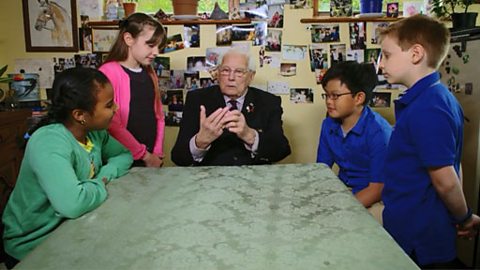The crew are almost ready to begin their interview, but first, they need to set up their shot.
We see an introduction to different types of film shots, including wide shots and close ups.
Advice is given about setting up a shot to ensure the camera is focused and different eye lines are explored in filming. The effect of changing to close up shots as an emotional tool is also explored.
We then see two clips that demonstrate interesting and different ways that other school children have filmed their interviews, as part of the ┤¾¤¾┤½├¢'s Make Film - Greatest Generation project.
In the first, the difference between wartime food and todayÔÇÖs food is discussed, while in the second, a mother talks about evacuation with her child.
The two films shown use very contrasting types of shot; the first is about women at war and the second looks at daily life.
Teacher Notes
Pupils could watch a variety of clips from different sources and look at different eye lines and shots that are used.
Ask them to analyse which they think works best and what would they use in their film? They could also practise setting up and framing interview shots and conduct 'mock' interviews with each other.
Curriculum Notes
This clip will be relevant for teaching Media Studies and History at Key Stage 2 in England, Wales and Northern Ireland and at Second Level in Scotland.
More from the series Filming our Greatest Generation
Finding the right interviewee. video
A group of children look at how to find interesting characters to interview for an World War Two history project.

Using archive footage or photographs. video
A group of children look at ways of illustrating their story using archive footage and photographs for a World War Two history project.

Good interview questions. video
A group of children explore the best ways to prepare interview questions for a World War Two history film project.

Choosing a good interview location. video
Under the guidance of ┤¾¤¾┤½├¢ producer, Steve Humphries, the children demonstrate why a good location is essential when interviewing for film.

Recording sound for an interview. video
A group of children look at how to set up clear sound recording when filming an interview for a World War Two history project.

Interviewing techniques. video
A group of children demonstrate key techniques a good interviewer can employ while filming their interview for a World War Two history project.

How to edit your interview. video
A group of children look at editing techniques for a World War Two history project.

Using music in a film project. video
A group of children look at how adding music can enhance their World War Two history project.

Adding voiceover to a film project. video
A group of children demonstrate how to use voiceover to enhance their World War Two history project.
